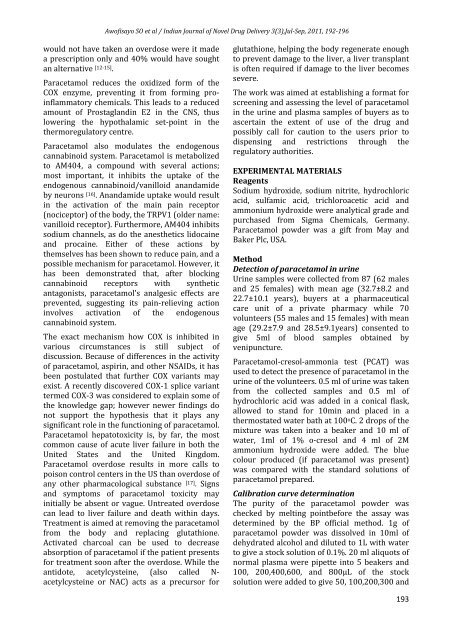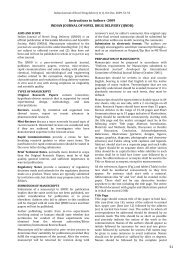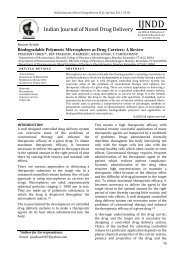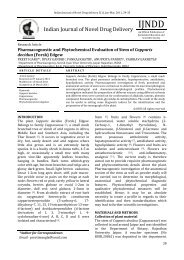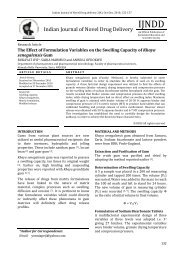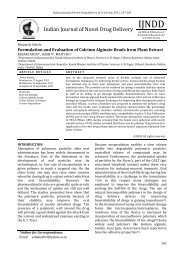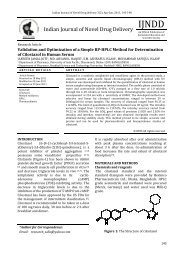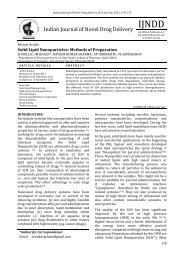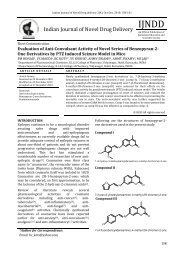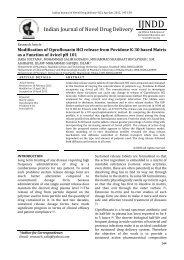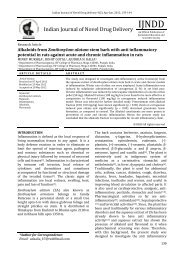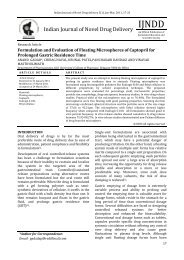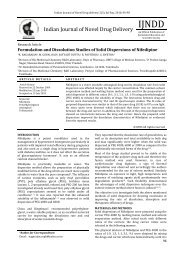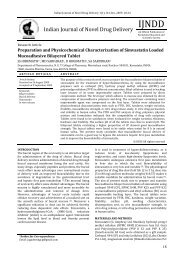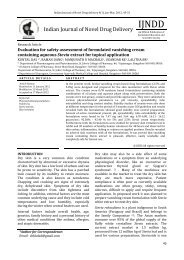Colorimetric Detection and Measurement of Paracetamol Exposure
Colorimetric Detection and Measurement of Paracetamol Exposure
Colorimetric Detection and Measurement of Paracetamol Exposure
Create successful ePaper yourself
Turn your PDF publications into a flip-book with our unique Google optimized e-Paper software.
Aw<strong>of</strong>isayo SO et al / Indian Journal <strong>of</strong> Novel Drug Delivery 3(3),Jul-Sep, 2011, 192-196<br />
would not have taken an overdose were it made<br />
a prescription only <strong>and</strong> 40% would have sought<br />
an alternative [12-15] .<br />
<strong>Paracetamol</strong> reduces the oxidized form <strong>of</strong> the<br />
COX enzyme, preventing it from forming proinflammatory<br />
chemicals. This leads to a reduced<br />
amount <strong>of</strong> Prostagl<strong>and</strong>in E2 in the CNS, thus<br />
lowering the hypothalamic set-point in the<br />
thermoregulatory centre.<br />
<strong>Paracetamol</strong> also modulates the endogenous<br />
cannabinoid system. <strong>Paracetamol</strong> is metabolized<br />
to AM404, a compound with several actions;<br />
most important, it inhibits the uptake <strong>of</strong> the<br />
endogenous cannabinoid/vanilloid an<strong>and</strong>amide<br />
by neurons [16] . An<strong>and</strong>amide uptake would result<br />
in the activation <strong>of</strong> the main pain receptor<br />
(nociceptor) <strong>of</strong> the body, the TRPV1 (older name:<br />
vanilloid receptor). Furthermore, AM404 inhibits<br />
sodium channels, as do the anesthetics lidocaine<br />
<strong>and</strong> procaine. Either <strong>of</strong> these actions by<br />
themselves has been shown to reduce pain, <strong>and</strong> a<br />
possible mechanism for paracetamol. However, it<br />
has been demonstrated that, after blocking<br />
cannabinoid receptors with synthetic<br />
antagonists, paracetamol's analgesic effects are<br />
prevented, suggesting its pain-relieving action<br />
involves activation <strong>of</strong> the endogenous<br />
cannabinoid system.<br />
The exact mechanism how COX is inhibited in<br />
various circumstances is still subject <strong>of</strong><br />
discussion. Because <strong>of</strong> differences in the activity<br />
<strong>of</strong> paracetamol, aspirin, <strong>and</strong> other NSAIDs, it has<br />
been postulated that further COX variants may<br />
exist. A recently discovered COX-1 splice variant<br />
termed COX-3 was considered to explain some <strong>of</strong><br />
the knowledge gap; however newer findings do<br />
not support the hypothesis that it plays any<br />
significant role in the functioning <strong>of</strong> paracetamol.<br />
<strong>Paracetamol</strong> hepatotoxicity is, by far, the most<br />
common cause <strong>of</strong> acute liver failure in both the<br />
United States <strong>and</strong> the United Kingdom.<br />
<strong>Paracetamol</strong> overdose results in more calls to<br />
poison control centers in the US than overdose <strong>of</strong><br />
any other pharmacological substance [17] . Signs<br />
<strong>and</strong> symptoms <strong>of</strong> paracetamol toxicity may<br />
initially be absent or vague. Untreated overdose<br />
can lead to liver failure <strong>and</strong> death within days.<br />
Treatment is aimed at removing the paracetamol<br />
from the body <strong>and</strong> replacing glutathione.<br />
Activated charcoal can be used to decrease<br />
absorption <strong>of</strong> paracetamol if the patient presents<br />
for treatment soon after the overdose. While the<br />
antidote, acetylcysteine, (also called N-<br />
acetylcysteine or NAC) acts as a precursor for<br />
glutathione, helping the body regenerate enough<br />
to prevent damage to the liver, a liver transplant<br />
is <strong>of</strong>ten required if damage to the liver becomes<br />
severe.<br />
The work was aimed at establishing a format for<br />
screening <strong>and</strong> assessing the level <strong>of</strong> paracetamol<br />
in the urine <strong>and</strong> plasma samples <strong>of</strong> buyers as to<br />
ascertain the extent <strong>of</strong> use <strong>of</strong> the drug <strong>and</strong><br />
possibly call for caution to the users prior to<br />
dispensing <strong>and</strong> restrictions through the<br />
regulatory authorities.<br />
EXPERIMENTAL MATERIALS<br />
Reagents<br />
Sodium hydroxide, sodium nitrite, hydrochloric<br />
acid, sulfamic acid, trichloroacetic acid <strong>and</strong><br />
ammonium hydroxide were analytical grade <strong>and</strong><br />
purchased from Sigma Chemicals, Germany.<br />
<strong>Paracetamol</strong> powder was a gift from May <strong>and</strong><br />
Baker Plc, USA.<br />
Method<br />
<strong>Detection</strong> <strong>of</strong> paracetamol in urine<br />
Urine samples were collected from 87 (62 males<br />
<strong>and</strong> 25 females) with mean age (32.7±8.2 <strong>and</strong><br />
22.7±10.1 years), buyers at a pharmaceutical<br />
care unit <strong>of</strong> a private pharmacy while 70<br />
volunteers (55 males <strong>and</strong> 15 females) with mean<br />
age (29.2±7.9 <strong>and</strong> 28.5±9.1years) consented to<br />
give 5ml <strong>of</strong> blood samples obtained by<br />
venipuncture.<br />
<strong>Paracetamol</strong>-cresol-ammonia test (PCAT) was<br />
used to detect the presence <strong>of</strong> paracetamol in the<br />
urine <strong>of</strong> the volunteers. 0.5 ml <strong>of</strong> urine was taken<br />
from the collected samples <strong>and</strong> 0.5 ml <strong>of</strong><br />
hydrochloric acid was added in a conical flask,<br />
allowed to st<strong>and</strong> for 10min <strong>and</strong> placed in a<br />
thermostated water bath at 100 o C. 2 drops <strong>of</strong> the<br />
mixture was taken into a beaker <strong>and</strong> 10 ml <strong>of</strong><br />
water, 1ml <strong>of</strong> 1% o-cresol <strong>and</strong> 4 ml <strong>of</strong> 2M<br />
ammonium hydroxide were added. The blue<br />
colour produced (if paracetamol was present)<br />
was compared with the st<strong>and</strong>ard solutions <strong>of</strong><br />
paracetamol prepared.<br />
Calibration curve determination<br />
The purity <strong>of</strong> the paracetamol powder was<br />
checked by melting pointbefore the assay was<br />
determined by the BP <strong>of</strong>ficial method. 1g <strong>of</strong><br />
paracetamol powder was dissolved in 10ml <strong>of</strong><br />
dehydrated alcohol <strong>and</strong> diluted to 1L with water<br />
to give a stock solution <strong>of</strong> 0.1%. 20 ml aliquots <strong>of</strong><br />
normal plasma were pipette into 5 beakers <strong>and</strong><br />
100, 200,400,600, <strong>and</strong> 800µL <strong>of</strong> the stock<br />
solution were added to give 50, 100,200,300 <strong>and</strong><br />
193


